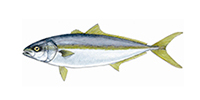Thank you for visiting the Seafood Selector. EDF is planning a new approach to providing information to consumers about good seafood choices. Please come back soon for updates.
Yellowtail

Yellowtail
Recommended servings per month
| Contaminant | Men | Women | Kids 6-12 | Kids 0-5 | |
|---|---|---|---|---|---|
| Yellowtail (farmed, Australia, Japan) | Mercury | 4+ | 4+ | 4+ | 4+ |
| Yellowtail (wild, Isla Natividad, Mexico) | Mercury | 4+ | 4+ | 4+ | 4+ |
| Yellowtail (wild, US, handline) | Mercury | 4+ | 4+ | 4+ | 4+ |
| Yellowtail (wild, US, gillnet) | Mercury | 4+ | 4+ | 4+ | 4+ |
Eco details:
For more information on the environmental impacts of yellowtail fishing and farming, visit the Monterey Bay Aquarium’s Seafood Watch® program.




